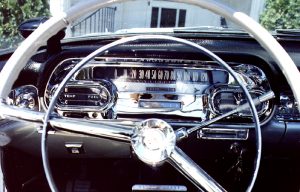Types or Stainless Restoration
In early automotive trim, the stainless steel was of high quality. By the early 1950s, an extraordinary amount of stainless and aluminum trim appeared on cars but it no longer met the same standards. As a result of the Korean Conflict, quality stainless steel was in short supply, and cheaper stainless had to be found. The difference between “superior” stainless and “inferior” stainless is a high level of iron in the latter. If noticeable amounts of rust don’t give it away (have you removed trim and found the fastening clips rust-welded to the back side?), an experiment will indicate the differences in the purity of the metal. Place a magnet on a Ford Model A grill shell: it will slide off. Place it on stainless produced after the early 50’s: there will be an attraction. Mind you, not a good type of attraction. Post-Korean Conflict pieces are flash-chromed to prevent rusting owing to the high iron content. Ironically, some of the worst quality stainless is on the automobiles with the most trim, where it is meant to be the most remarkable – like late 50’s General Motors cars.
 Flash-chromed stainless trim poses potentially serious problems at the start of the restoration process. Anything that has compromised the thin chrome finish – a stone ding, slight scratch, or any fracture in the chrome veneer – results in unseen damage to both the front and back surfaces of this trim. The entire piece becomes vulnerable. Water, road salt and other chemicals work their way through these slightly damaged areas, and can cause pits and corrosion beneath the chrome. This can start from the back (usually around metal clips) and work its way to the surface or start at the surface and work its way toward the back. Sometimes they meet each other. Therefore, what looks like a small imperfection can grow in size the more you try to fix it, usually by sanding the surface. Frequently, this leads to creating a hole, or a cluster of abrasions, on the surface of your trim.
Flash-chromed stainless trim poses potentially serious problems at the start of the restoration process. Anything that has compromised the thin chrome finish – a stone ding, slight scratch, or any fracture in the chrome veneer – results in unseen damage to both the front and back surfaces of this trim. The entire piece becomes vulnerable. Water, road salt and other chemicals work their way through these slightly damaged areas, and can cause pits and corrosion beneath the chrome. This can start from the back (usually around metal clips) and work its way to the surface or start at the surface and work its way toward the back. Sometimes they meet each other. Therefore, what looks like a small imperfection can grow in size the more you try to fix it, usually by sanding the surface. Frequently, this leads to creating a hole, or a cluster of abrasions, on the surface of your trim.
Another issue with flash-chrome trim: the more you polish it, the worse it may look. The surface can take on the appearance of orange peel,akin to paint before it is color sanded. Why? The heat from polishing has melted off iron molecules, and this results in an uneven surface.
I cannot overstate the importance of the following: not all stainless trim can be restored, even if it looks straight and has no dents. If your trim has small brown spots on the surface, it is rust. Most of the time, what you see is a small indication of the damage that the piece has sustained.

